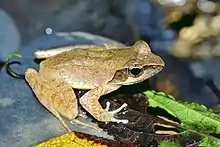Rana sauteri
Rana sauteri is a species of true frog endemic to Taiwan. It inhabits low-altitude hill forests and the associated streams. It is an endangered species threatened by habitat loss due to agriculture and infrastructure development.[1] Common names recorded for Rana sauteri include Kanshirei Village frog, Taiwan groove-toed frog, Sauter's brown frog, and Taiwan pseudotorrent frog.[2]
| Rana sauteri | |
|---|---|
 | |
| Scientific classification | |
| Domain: | Eukaryota |
| Kingdom: | Animalia |
| Phylum: | Chordata |
| Class: | Amphibia |
| Order: | Anura |
| Family: | Ranidae |
| Genus: | Rana |
| Species: | R. sauteri |
| Binomial name | |
| Rana sauteri Boulenger, 1909 | |
| Synonyms | |
| |
Taxonomy
Rana sauteri was first described in 1909 by George Albert Boulenger on the basis of specimens collected on Taiwan by one H. Sauter. Boulenger noted resemblances to Rana japonica and Rana mortenseni (now Hylarana mortenseni) and thought the species bridged part of the gap between Hylorana (now spelled Hylarana) and the Rana temporaria group of species.[3] In 1920, however, Boulenger placed the species in the subgenus Hylorana of the genus Rana.[4] In 1991, Fei and colleagues placed it in a new genus Pseudorana together with Rana sangzhiensis and Rana weiningensis, and in 2000 they even placed it in a genus of its own, Pseudoamolops, because they thought it was more closely related to Amolops frogs than to other species of Pseudorana.[5] However, molecular data place Rana sauteri well within the genus Rana, particularly the Rana temporaria group, and in 2006 Frost and colleagues therefore placed Pseudoamolops sauteri back in Rana.[6]
In 1921, Smith described Rana sauteri var. johnsi as a variety of Rana sauteri from Vietnam. This form, which also occurs in Guangxi (southern China), Laos, Cambodia, and Thailand, has been recognized as a separate species, Rana johnsi (previously Pseudorana johnsi) since 1999.[7] In addition, high-altitude populations of Rana sauteri were recognized as a separate species, Rana multidenticulata, in 1997.[8]
Description
Rana sauteri are medium-sized frogs: males grow to a snout–vent length of 35 mm (1.4 in) and females to 47 mm (1.9 in).[9] They have a slender body with brown, red brown or dark brown upper surface.[10]
Conservation
There is currently a Sauter's frog conservation project in the Dashanbei area of Hengshan Township (橫山鄉), Hsinchu County.[11]
References
- IUCN 2020.
- Frost 2011, Rana sauteri Boulenger, 1909.
- Boulenger 1909, p. 493.
- Boulenger 1920, pp. 123, 129.
- Frost et al. 2006, p. 100.
- Frost et al. 2006, p. 254.
- Frost 2011, Rana johnsi Smith, 1921.
- Frost 2011, Rana multidenticulata Chou and Lin, 1997.
- Fei, L. (1999). Atlas of Amphibians of China (in Chinese). Zhengzhou: Henan Press of Science and Technology. p. 170. ISBN 7-5349-1835-9.
- Lue, Kuang-Yang. "Rana sauteri". BiotaTaiwanica. Retrieved 26 March 2014.
- "Eco-echo Ecological Conservation Hope Project - UMC".
Literature cited
- Boulenger, G.A. (1909). "Descriptions of four new frogs and a new snake discovered by Mr. H. Sauter in Formosa". Annals and Magazine of Natural History. 4: 492–495. doi:10.1080/00222930908692704.
- Boulenger, G.A. (1920). "A monograph of the South Asian, Papuan, Melanesian and Australian frogs from the genus Rana". Records of the Indian Museum. 20: 1–226.
- Frost, D.R. (2011). "Amphibian Species of the World: an Online Reference. Version 5.5". New York: American Museum of Natural History.
- Frost, D. R.; Grant, T.; Faivovich, J. N.; Bain, R. H.; Haas, A.; Haddad, C. L. F. B.; De Sá, R. O.; Channing, A.; Wilkinson, M.; Donnellan, S. C.; Raxworthy, C. J.; Campbell, J. A.; Blotto, B. L.; Moler, P.; Drewes, R. C.; Nussbaum, R. A.; Lynch, J. D.; Green, D. M.; Wheeler, W. C. (2006). "The Amphibian Tree of Life". Bulletin of the American Museum of Natural History. 297: 1–291. doi:10.1206/0003-0090(2006)297[0001:TATOL]2.0.CO;2. hdl:2246/5781. S2CID 86140137.
- IUCN SSC Amphibian Specialist Group (2020). "Rana sauteri". IUCN Red List of Threatened Species. 2020. Retrieved 1 January 2021.
